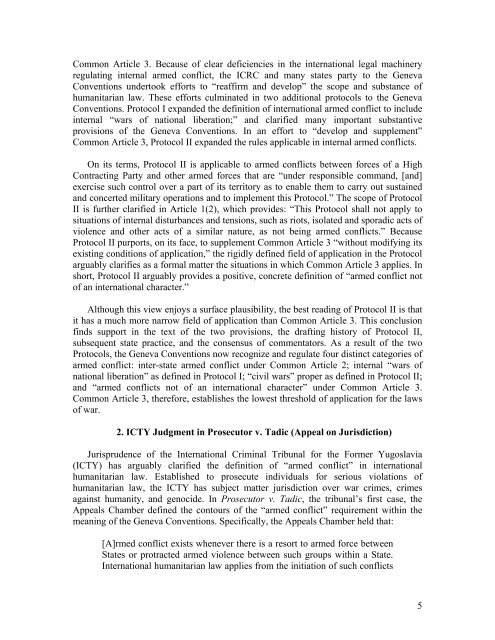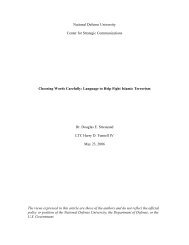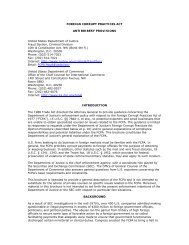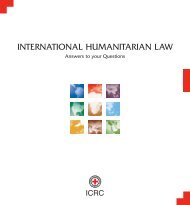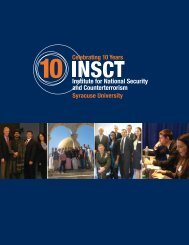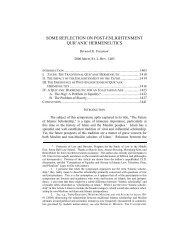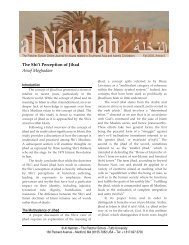the temporal scope of application of international humanitarian law ...
the temporal scope of application of international humanitarian law ...
the temporal scope of application of international humanitarian law ...
Create successful ePaper yourself
Turn your PDF publications into a flip-book with our unique Google optimized e-Paper software.
Common Article 3. Because <strong>of</strong> clear deficiencies in <strong>the</strong> <strong>international</strong> legal machinery<br />
regulating internal armed conflict, <strong>the</strong> ICRC and many states party to <strong>the</strong> Geneva<br />
Conventions undertook efforts to “reaffirm and develop” <strong>the</strong> <strong>scope</strong> and substance <strong>of</strong><br />
<strong>humanitarian</strong> <strong>law</strong>. These efforts culminated in two additional protocols to <strong>the</strong> Geneva<br />
Conventions. Protocol I expanded <strong>the</strong> definition <strong>of</strong> <strong>international</strong> armed conflict to include<br />
internal “wars <strong>of</strong> national liberation;” and clarified many important substantive<br />
provisions <strong>of</strong> <strong>the</strong> Geneva Conventions. In an effort to “develop and supplement”<br />
Common Article 3, Protocol II expanded <strong>the</strong> rules applicable in internal armed conflicts.<br />
On its terms, Protocol II is applicable to armed conflicts between forces <strong>of</strong> a High<br />
Contracting Party and o<strong>the</strong>r armed forces that are “under responsible command, [and]<br />
exercise such control over a part <strong>of</strong> its territory as to enable <strong>the</strong>m to carry out sustained<br />
and concerted military operations and to implement this Protocol.” The <strong>scope</strong> <strong>of</strong> Protocol<br />
II is fur<strong>the</strong>r clarified in Article 1(2), which provides: “This Protocol shall not apply to<br />
situations <strong>of</strong> internal disturbances and tensions, such as riots, isolated and sporadic acts <strong>of</strong><br />
violence and o<strong>the</strong>r acts <strong>of</strong> a similar nature, as not being armed conflicts.” Because<br />
Protocol II purports, on its face, to supplement Common Article 3 “without modifying its<br />
existing conditions <strong>of</strong> <strong>application</strong>,” <strong>the</strong> rigidly defined field <strong>of</strong> <strong>application</strong> in <strong>the</strong> Protocol<br />
arguably clarifies as a formal matter <strong>the</strong> situations in which Common Article 3 applies. In<br />
short, Protocol II arguably provides a positive, concrete definition <strong>of</strong> “armed conflict not<br />
<strong>of</strong> an <strong>international</strong> character.”<br />
Although this view enjoys a surface plausibility, <strong>the</strong> best reading <strong>of</strong> Protocol II is that<br />
it has a much more narrow field <strong>of</strong> <strong>application</strong> than Common Article 3. This conclusion<br />
finds support in <strong>the</strong> text <strong>of</strong> <strong>the</strong> two provisions, <strong>the</strong> drafting history <strong>of</strong> Protocol II,<br />
subsequent state practice, and <strong>the</strong> consensus <strong>of</strong> commentators. As a result <strong>of</strong> <strong>the</strong> two<br />
Protocols, <strong>the</strong> Geneva Conventions now recognize and regulate four distinct categories <strong>of</strong><br />
armed conflict: inter-state armed conflict under Common Article 2; internal “wars <strong>of</strong><br />
national liberation” as defined in Protocol I; “civil wars” proper as defined in Protocol II;<br />
and “armed conflicts not <strong>of</strong> an <strong>international</strong> character” under Common Article 3.<br />
Common Article 3, <strong>the</strong>refore, establishes <strong>the</strong> lowest threshold <strong>of</strong> <strong>application</strong> for <strong>the</strong> <strong>law</strong>s<br />
<strong>of</strong> war.<br />
2. ICTY Judgment in Prosecutor v. Tadic (Appeal on Jurisdiction)<br />
Jurisprudence <strong>of</strong> <strong>the</strong> International Criminal Tribunal for <strong>the</strong> Former Yugoslavia<br />
(ICTY) has arguably clarified <strong>the</strong> definition <strong>of</strong> “armed conflict” in <strong>international</strong><br />
<strong>humanitarian</strong> <strong>law</strong>. Established to prosecute individuals for serious violations <strong>of</strong><br />
<strong>humanitarian</strong> <strong>law</strong>, <strong>the</strong> ICTY has subject matter jurisdiction over war crimes, crimes<br />
against humanity, and genocide. In Prosecutor v. Tadic, <strong>the</strong> tribunal’s first case, <strong>the</strong><br />
Appeals Chamber defined <strong>the</strong> contours <strong>of</strong> <strong>the</strong> “armed conflict” requirement within <strong>the</strong><br />
meaning <strong>of</strong> <strong>the</strong> Geneva Conventions. Specifically, <strong>the</strong> Appeals Chamber held that:<br />
[A]rmed conflict exists whenever <strong>the</strong>re is a resort to armed force between<br />
States or protracted armed violence between such groups within a State.<br />
International <strong>humanitarian</strong> <strong>law</strong> applies from <strong>the</strong> initiation <strong>of</strong> such conflicts<br />
5


